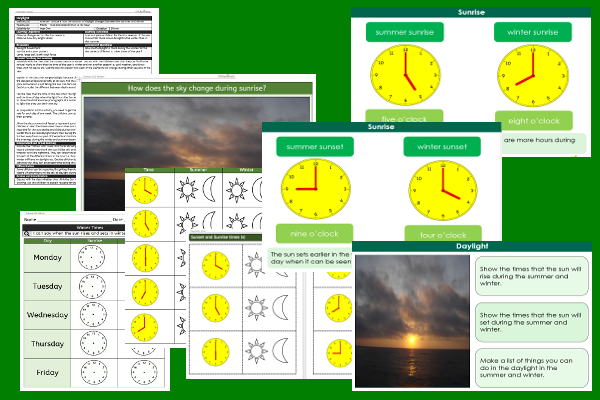Home > Key Stage One > Science > Year One Planning > Winter
Lesson Three – Daylight

This science teaching pack for Key Stage One gets the children to identify, record and compare how the amount of daylight and nighttime can change between the summer and winter seasons of the year.
The class can observe and make a list of the sunrise and sunset times that can occur during each season of the year using diagrams and matching times to the hour.
Download this teaching pack including a lesson plan, classroom activities and an interactive presentation to identify, record and compare how the amount of daylight and nighttime can change between the summer and winter seasons of the year
Activities in this teaching pack include display posters to identify and describe how the sky might appear during different times of the day, a template to record sunrise and sunset times for one week during winter as a homework task and sets of cards to observe and record times to the hour when there might be daylight during the winter.
The interactive presentation gets the children to explore how the amount of daylight changes between the summer and winter seasons of the year.
This lesson is part of a science scheme of work to get the children to identify, observe and record some of changes to the natural world during the winter season including changes to daylight hours, temperature and animal habitats. There are teaching activities for shared learning, differentiated worksheets to support independent learning and interactive presentations to introduce concepts and key skills.
-

Maths Measurement Assessment
Assess abilities in estimating, measuring and comparing a range of different measurements for length, mass and capacity
-

Family Life
Investigate and reflect on some of the special events and experiences that might happen in the life of a family
-

Final Sounds Word Guess
Practise playing some guessing and matching games to identify the spelling and meaning of words with different final sounds
-

Building Reports
Explore how to collect facts and information to work with when composing and presenting non-chronological reports about buildings that can be found in the local area
